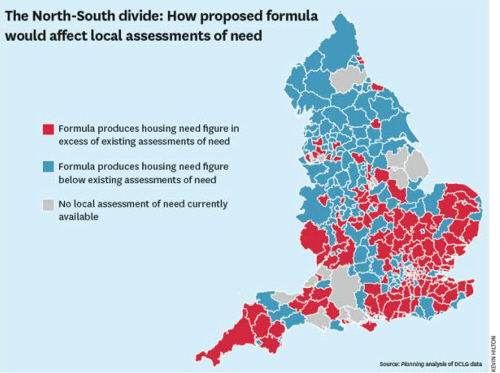The new NPPF and housing need
 Josef Cannon sets out what you need to know about the new National Planning Policy Framework and housing need.
Josef Cannon sets out what you need to know about the new National Planning Policy Framework and housing need.
The changes announced in the revised NPPF (NPPF2) cover the new approach to delivering housing, following the Government’s White Paper commitment to “fix the broken housing market” by delivering more homes per year than ever before – the stated ambition is to build 300,000 homes a year.
The subsequent consultation Planning for the Right Homes in the Right Places was accompanied by a proposed draft ‘standard methodology’ for calculating Objectively Assessed Housing Need (OAN). This was intended to replace the present system, by which a (broadly) council-by-council approach is recommended, albeit one starting with the official projections issued every two years by the Government. These ‘predict’ the number of new households likely to form each year by projecting forward past trends in household formation and population growth.
There is scope within the PPG to look at whether past trends exhibit the effects of “suppression” locally by for example insufficient numbers of homes having been built to meet demand, and adjusting them accordingly – as well as by reference to “market signals” and future job growth.
The approach has undoubtedly been good for planning lawyers and consultants – extending the length and complexity of otherwise ordinary planning appeals by many days in some cases.
In short, the proposals in the consultation have been confirmed. Instead of the PPG approach described above, local authorities should take the official projections published by the Government, calculate the average growth projected over the next ten years, and then uplift that number by a factor relating to the local ‘affordability ratio’: the relationship between house prices and earnings.

These affordability ratios, too, are published by ONS at local authority level. This results in a relatively straightforward formula. There is then a ‘cap’, meaning that the uplift cannot result in an increase in OAN of more than 40% above the housing need number set out in a recently-adopted plan, or the average household growth projection if there is no recently-adopted plan.
Using this proposed approach the Government also published an indicative table showing, for each local authority, what the likely “new” housing need would be, applying that formula. Surprisingly, given the aspiration to deliver 300,000 new homes a year, it suggested a total figure of 266,000. The implication was that some authorities would be expected to deliver more than their minimum need implied by the new approach. It also implied a stark north-south split in delivery, with large increases in need in the relatively unaffordable south-east, and reductions in the north and north-west:
The announcement of the revised NPPF confirmed this new approach, but contained a fascinating caveat: the new household projections are expected in September 2018, and are widely expected to imply a significantly lower future rate of household growth nationally.
Given that these new projections will be the starting point for the formula (see above), it would follow that they might result in a lower overall delivery number. As a result, the Government wish to be free to abandon their approach published yesterday if that turns out to be the case and “consider adjusting the method” after the projections are published – with another consultation to come. It is an odd caveat given the central reliance placed on those official projections: one might think that if they implied lower household growth in the future, that would logically translate into reduced need – but the “aspiration” to deliver more homes seems to have trumped that logic.
The announcement also confirmed the Housing Delivery Test Rule Book, by which local authorities will be judged as to their success in delivering homes (of course, it is not local authorities who actually deliver homes, but housebuilders, by and large). The approach requires a comparison of net homes delivered over three years with the three year average need figure, calculated as above.
This is used within the new NPPF in a number of places: rendering relevant development plan policies “out of date” in paragraph 11; as to the effect of neighbourhood plans (para. 14); as to the appropriate “buffer” to apply to the need figure (paragraph 73). It will apply from November 2018.
Josef Cannon is a barrister at Cornerstone Barristers.






